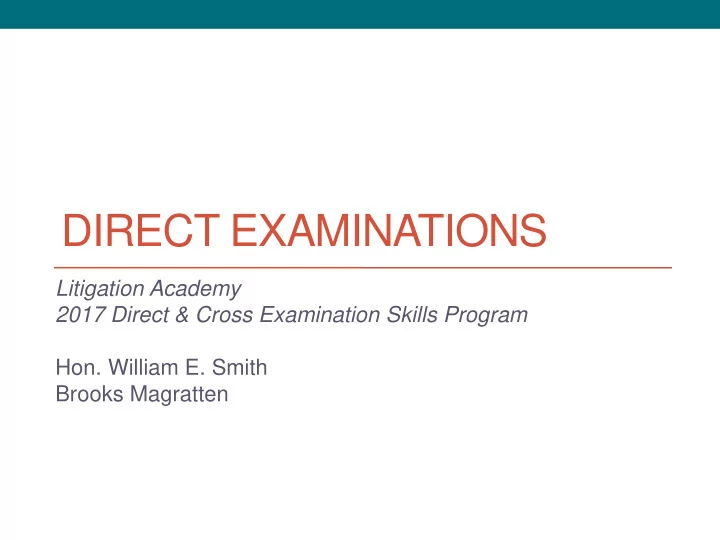

DIRECT EXAMINATIONS Litigation Academy 2017 Direct & Cross Examination Skills Program Hon. William E. Smith Brooks Magratten
Direct v. Cross Examination
FRE 601: Competency to Testify • Every person is competent to be a witness unless these rules provide otherwise. • Where state law supplies the rule of decision, then state law governs the witness’s competency to testify.
FRE 602: Need for Personal Knowledge • A witness may testify to a matter only if evidence is introduced sufficient to support a finding that the witness has personal knowledge of the matter. • Evidence to prove personal knowledge may consist of the witness’s own testimony.
What is a Leading Question?
What is a Leading Question? 1. Tell us what you saw as you entered the intersection. 2. What was the color of the light when you entered the intersection? 3. Was the stoplight green when you entered the intersection? 4. The light was green when you entered the intersection, right?
You can lead on direct…sometimes • Witness background • Undisputed matters • Foundation to admit exhibits • Hostile witnesses • Problem witnesses (FRE 611(c))
Structure of the Direct Examination • Chronological • Impact
Use a Picture Frame • Give your witness context. • Help focus your witness’s testimony.
Lay Opinion (FRE 701) • Lay opinion must be: a) rationally based on the witness’s perception; b) helpful to clearly understanding the witness’s testimony or to determining a fact in issue; c) not based on scientific, technical, or other specialized knowledge.
Diction
Moving Exhibits In Evidence • Ask witness to identify the document / thing. • Have witness explain why they recognize the document / thing. • Lay the foundation. See Chapter 7, Trials.
Prepare Your Witness • Review testimony with your witness. • Show witness the courtroom. • Make sure the witness knows what to expect.
Bring Testimony To Life • Consider using demonstrative aids. • Get your witness on their feet. • Weave exhibits into the story. • Be careful about having your witness draw.
Refreshing Recollection Witnesses will forget important facts. 1. Show the witness the document / object that may 2. refresh recollection. Ask the witness if the document / object refreshes their 3. recollection about the facts at issue. Take the document / object away from the witness. 4. Have the witness testify from their refreshed 5. recollection.
Redirect • Don’t do it unless you need to. • Keep it short. • Stay within scope of cross.
Quinlan v. Kane • Prepare 12 – 15 minutes of direct exam. • Prepare your witness tomorrow. • Email opposing counsel about topics you plan to cover. • Think about exhibits. • Think about documents / objects you can use to refresh recollection.
Questions?
CONTACT Brooks Magratten Prof. Niki Kuckes Pierce Atwood LLP RWU School of Law 72 Pine Street Ten Metacomet Ave. Providence, RI 02903 Bristol, RI 02809 bmagratten@pierceatwood.com nkuckes@rwu.edu 401-490-3422 401-254-4505
Recommend
More recommend